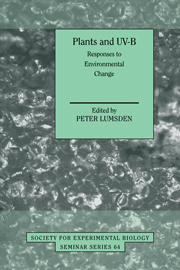Book contents
- Frontmatter
- Contents
- List of contributors
- Preface
- PART I The ozone layer and UV-B radiation
- PART II Effects of UV-B on plants at the cellular level
- DNA damage and repair in plants
- Genetic analysis of DNA repair in plants
- Photosynthesis and photoinhibition
- UV-B effects on the expression of genes encoding proteins involved in photosynthesis
- UV-B perception and signal transduction
- Ultraviolet radiation as a stress factor and the role of protective pigments
- PART III Effects of UV-B at the whole plant and community level
- Index
Photosynthesis and photoinhibition
Published online by Cambridge University Press: 04 August 2010
- Frontmatter
- Contents
- List of contributors
- Preface
- PART I The ozone layer and UV-B radiation
- PART II Effects of UV-B on plants at the cellular level
- DNA damage and repair in plants
- Genetic analysis of DNA repair in plants
- Photosynthesis and photoinhibition
- UV-B effects on the expression of genes encoding proteins involved in photosynthesis
- UV-B perception and signal transduction
- Ultraviolet radiation as a stress factor and the role of protective pigments
- PART III Effects of UV-B at the whole plant and community level
- Index
Summary
Introduction
Photosynthesis and photosynthetic productivity in many plant species, although by no means all, can be inhibited by increased exposure to UV-B radiation (Caldwell, Teramura & Tevini, 1989; Tevini & Teramura, 1989; Teramura, Ziska & Sztein, 1991; Tevini, Braun & Fieser, 1991; Middleton & Teramura, 1993; Musil, 1995). To date, there is no consensus for the mechanistic basis of UV-B-induced inhibition of CO2 assimilation in mature leaves. Decreases in Rubisco activity and stomatal conductance have been implicated as factors limiting CO2 assimilation in leaves exposed to elevated levels of UV-B. Prolonged exposure to elevated levels of UV-B has been demonstrated to result in decreases in both Rubisco activity and content (Vu, Allen & Garrard, 1984; Strid, Chow & Anderson, 1990; Jordan et al., 1992; He et al, 1993), and is accompanied by large decreases in the mRNA transcripts of both the large and small subunits of Rubisco (Jordan et al, 1992). Such decreases in Rubisco are consistent with the observed decrease in the leaf carboxylation efficiency, determined from the initial slope of the response of CO2 assimilation to increasing CO2 concentration, when leaves are given supplemental UV-B radiation (Ziska & Teramura, 1992). Exposure to UV-B can also modify the rates of stomatal opening and closing, and reduce the rate of leaf transpiration (Tevini & Teramura, 1989; Middleton & Teramura, 1993; Day & Vogelmann, 1995).
- Type
- Chapter
- Information
- Plants and UV-BResponses to Environmental Change, pp. 95 - 112Publisher: Cambridge University PressPrint publication year: 1997
- 40
- Cited by



